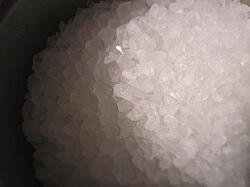 Anti-icing and de-icing are key elements in the snow removal industry. When it comes to melting ice, you need to start early and spread often because prevention of the ice from forming is the goal. Using a combination of anti-icing and de-icing methods can save you time and money. But before you can begin to prevent ice, you must understand how de-icing materials work.
Anti-icing and de-icing are key elements in the snow removal industry. When it comes to melting ice, you need to start early and spread often because prevention of the ice from forming is the goal. Using a combination of anti-icing and de-icing methods can save you time and money. But before you can begin to prevent ice, you must understand how de-icing materials work.
There are several de-icing material options. However, most ice melt is generally comprised of 7 basic chemicals. These chemicals being:
-
Sodium Chloride (Common Rock Salt)
-
Calcium Chloride
-
Magnesium Chloride
-
Calcium Magnesium Acetate (CMA)
-
Potassium Acetate
-
A range of Calcium blends
-
Liquids, mostly organic
When considering de-icing material for your snow and ice removal account, the supplier of material will generally provide additional information and help you find the right product for your needs. The ingredients above and the product characteristics below in this guide are important considerations and recommended areas to research further when selecting the correct product for the job.
Melting Temperatures. The chemicals found in ice-melt affect how the snow and ice will melt in many different ways. Their melting temperatures, the lowest temperature at which they can melt ice, vary greatly. This temperature is also referred to as how “hot” the material is. Calcium Chloride, for example, can melt ice all the way down to -25° F while Sodium Chloride (rock salt) only melts to 5° F. Spreading a material whose melting temperature is not “hot” enough for the current conditions is a waste of both time and money. When purchasing de-icing material take special note of the material and melting temperatures.
Environment. You cannot make a decision on a product purely on how “hot” the de-icer is. You should also consider how damaging it could be to the environment. Some chemicals are much more damaging to the grass and surrounding growth, like rock salt, which could be an issue with certain clients. Magnesium Chloride, on the other hand, is gentler on the grass than salt. You should also be aware that certain products could be damaging to the ground water when runoff occurs.
Availability. Some de-icers are more readily available, depending on where you live. Rock salt is one of the most readily available forms of ice melt. Other de-icers composed of certain chemicals aren’t always available at local stores, so you may have to travel out of town or order them online to purchase the needed material. The quantity you’re looking to buy in and where the de-icers are produced will also affect the availability.
Size. Ice melt can be either coarse or fine or anywhere in between. Different sized particles serve different purposes. A larger particle will be heavier. Meaning, as it melts, it can sink down into deeper snow that hasn’t been plowed away yet, all the way to the pavement. On the other hand, finer particles are smaller and therefore not as heavy, but they cover a greater amount of surface area.
Quality. Quality of ice melt is an important factor in deciding what you should buy. Many larger or municipal sized contractors need a large quantity ice melt. That being the case, they will often buy “bulk” rock salt. Bulk rock salt is less costly because it is only screened once, which results in leftover fine, wet particles in the mixture. These particles are not beneficial in melting ice and often get stuck in the spreader’s moving parts. Higher grade equipment can usually handle this, but for those with lower grade equipment may want to consider purchasing bagged rock salt as it is screened 3 times making it dryer and more even. That way, it is less demanding on the equipment.
Your Spreader System. The spreader system that you’re using will be impacted by the type of de-icing material you use. Pintel chain, auger, or paddle and how large or small they are, all work differently with different materials based on the size and quality of the de-icers. The number of motors and accessories you have, such as a vibrator, will also be important factors to consider when deciding what to buy for your spreader. It is beneficial to have a fully sealed motor, preferably stainless steel, as salt, when wet, can be very damaging to the motor. Being fully enclosed helps prevent damage internally and the stainless steel resists corrosion. Finally, the size of your spreader will help determine what de-icing material to buy. Larger spreaders may allow for a wider range of different materials, while some smaller, lower grade spreaders may be better off with a smaller range of products.
Storage. Before purchasing de-icing material, you need to consider how much room you have to store it. De-icing material is often hydroscopic, meaning it absorbs water. That being the case, it needs to be stored in a dry place away from liquids. The amount of available dry space you have may determine how much you should buy.
Price. The price of de-icing material is dependent on all of the above. “Hotter” chemicals and higher quality will be more expensive. Prices could be higher or lower depending on size, as well. Sometimes a de-icer won’t be available in your town meaning you’ll either have to travel or order it online. Material that varies in the way it affects the environment could also change the price. You’ll also need to consider your storage options. De-icers should be stored in a dry place. Availability of space may limit how much you can purchase. The type of job you’re doing and your spreading equipment will help dictate what you need to buy.
There are many different options available when purchasing ice-melt. It comes in numerous different forms and is made up of various chemicals. Finding de-icing material that is right for you depends upon the type of job you’re doing and your spreading equipment. Look to the supplier of the de-icing material, as they will most likely provide you with additional information and help you find the right product for your needs.
photo credit: nate steiner via photopin cc







